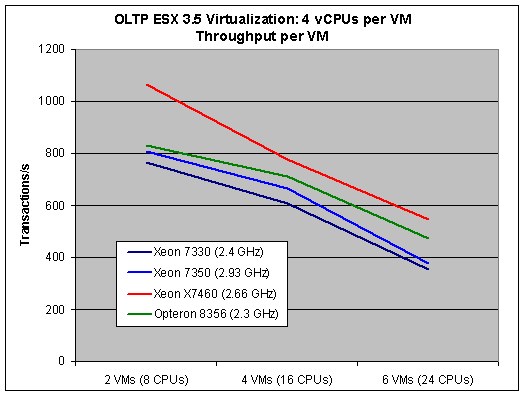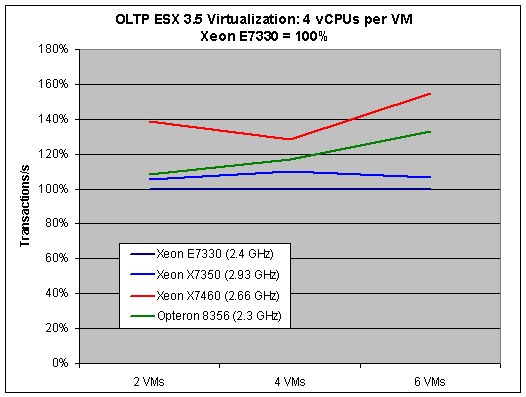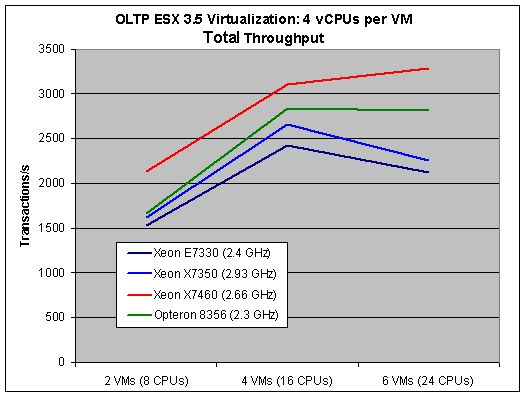Intel Xeon 7460: Six Cores to Bulldoze Opteron
by Johan De Gelas on September 23, 2008 12:00 AM EST- Posted in
- IT Computing
ESX 3.5 Update 2 Virtualization Results
Disclaimer: Do not try to interpret these results if you are in a hurry!
We apologize for this warning to our astute readers, for whom it will be obvious that you cannot simply take the following graphs at face value. Unfortunately, many people tend to skip the text and just look at the pictures, which could lead to many misinterpretations. We want to make it clear that when you combine three different software layers - Hypervisor, OS or "Supervisor", and Server Application - on top of different hardware, things get very complex.
In our very first virtualization benchmark, we give each VM four virtual CPUs. With two and four VMs, we do not "oversubscribe", i.e. each virtual CPUs corresponds at least one physical CPU. In the case of six VMs, we oversubscribe some of the servers: the Xeon 73xx (Tigerton) and Opteron (Barcelona) platforms only have 16 physical CPUs, and we allocate 24. Oversubscribing is a normal practice in the virtualization world: you try to cut your costs by putting as many servers as is practical on one physical server. It's rare that all your servers are running at 100% load simultaneously, so you allow one VM to use some of the CPU power that another VM is not currently using. That is the beauty of virtualization consolidation after all: making the best use of the resources available.
The virtual CPUs are not locked to physical cores; we let the hypervisor decide which virtual CPU corresponds to which physical CPU. There is one exception: we enable NUMA support for the Opteron of course. For now, we limit ourselves to six VMs as several non-CPU related (probably storage) bottlenecks kick in as we go higher. We are looking at how we can test with more VMs, but this will require additional research.
This limit is a perfect example for understanding how complex virtualization testing can get. We could disable flushing the logs immediately after commit, as this would reduce the stress on our disk system,and make it a more CPU limited benchmark even with more than six VMs. However, this would mean that our test loses ACID compliance, which is important for an OLTP test. In a native test, this may be acceptable if you are just looking to test the CPU performance; it's probably just a matter of adding a few more spindles. However, this kind of reasoning is wrong when you work with virtualized servers. By disabling the immediate flushing of logs, you are lowering the impact on the hypervisor in several ways. Your hypervisor has to do less work, hence the impact on the CPU is lowered, and the objective of this test is to see how well a CPU copes with a virtualized environment.
Consolidation courtesy of virtualization is a compromise between performance per VM and total throughput of the physical machine. You want to put as many virtual servers as possible on one physical server to maximize throughput and cost reduction, but you do not want to see individual VM performance decrease below a certain threshold. If you sacrifice too much individual virtual server performance in order to get more VMs on one server, your CFO will be happy but your users will complain. It is therefore important to look at both the performance per virtual server and total throughput of the physical machine. The first graph shows you the number of transactions per Virtual Server. For those interested, this is an average and individual virtual servers show +/-5% compared to this average.

As expected, the highest result per virtual server is achieved if we only run two VMs. That is normal, since it means that the physical server has eight CPUs left to handle the console and hypervisor overhead. Nevertheless, those two factors cannot explain why our results fall so much once we activate four VMs and all 16 CPUs cores are busy.
| Performance loss from 2 VMs to 4 VMs | |
| Xeon 7330 (2.4GHz) | -21% |
| Xeon 7350 (2.93GHz) | -17% |
| Xeon X7460 (2.66GHz) | -27% |
| Opteron 8356 (2.3GHz) | -15% |
Our internal tests show that you should expect the Hypervisor to require about 12% of the CPU power per VM and the impact of the console should be minimal. In the first test (two VMs) there is more than enough CPU power available as we use only half (Opteron 8356, Xeon 73xx servers) to one third (X7460 server) of what is available. The real performance losses however are in the range of 15% (Opteron) to 27% (Xeon X7460). So where is the other bottleneck?
The database is 258MB per VM, and therefore runs almost completely in our INNODB buffer pool. We suspect the extra performance comes from the extra bandwidth that two extra VMs demand. Notice how the Opteron - the server with the highest bandwidth - has the lowest loss. That gives us our first hint, as we know that more VMs also result in higher bandwidth demands. Secondly, we see that the Xeon X7350 loses a little less than the E7330 (percentagewise) when you fire up two extra VMs. The slightly bigger cache on the X7350 (2x4MB) reduces the pressure on the memory a bit.
Next, we compare the architectures. To do this, we standardize the Xeon E7330 (2.4GHz) result to 100%.

This graph is worth a very close investigation, since we can study the impact of the CPU core architecture. As we are using only eight CPUs and 4GB if we run two VMs, the Xeon 7460 cannot leverage its most visible advantage: the two extra cores. With two VMs, performance is mostly determined - in order of importance - by:
- (Futex) Thread synchronization (we have up to 32 threads working on the database per VM)
- Raw integer crunching power
- VM to Hypervisor switching time (to a lesser degree)
The X7460 is based on the Penryn architecture. This 45nm Intel core features slightly improved integer performance but also significantly improved "VM to Hypervisor" switching time. On top of that, synchronization between CPUs is a lot faster in the X74xx series thanks to the large inclusive L3 cache that acts as filter. Memory latency is probably great too, as the VMs are probably running entirely in the L2 and L3 caches. That is the most likely reason why we see the X7460 outperform all other CPUs.
Once we add two more VMs, we add 4GB and eight CPUs that the hypervisor has to manage. Memory management and latency become more important, and the Opteron advantages come into play: the huge TLB ensures that TLB misses happen a lot less. The TLB is also tagged, making sure "VM to Hypervisor" switching does not cause any unnecessary TLB flushes. As we pointed out before, the complex TLB of the Barcelona core - once the cause of a PR nightmare - now returns to make the server platform shine. We measured that NPT makes about a 7-8% difference here. That might not seem impressive at first sight, but a single feature capable of boosting the performance by such a large percentage is rare. The result is that the Opteron starts to catch up with the Xeon 74xx and outperforms the older 65nm Xeons.
The impact of memory management only gets worse as we add two more VMs. The advantages described above allow the Opteron to really pull away from the old Xeon 73xx generation. However, in this case the Xeon X7460 can leverage its eight remaining cores, while the Opteron and older Xeon servers do not have that luxury. The hypervisor has to juggle six VMs that are demanding 24 cores, while there are only 16 cores available on the Opteron and Xeon 73xx servers. That is why in this case the Xeon X7460 is again the winner here: it can consolidate more servers at a given performance point than the rest of the pack.
To appreciate what the 6-core Xeon is doing, we need to look at the total throughput.

Notice how the Opteron is able to keep performance more or less stable once you demand 24 virtual CPUs, while the performance of Xeon 73xx takes a nosedive. The winner is of course the Intel hex-core, which can offer 24 real cores to the hypervisor. The Dunnington machine is capable of performing almost 3300 transactions per second, or no less than 45% more than its older brother that is clocked 11% higher. The Opteron does remarkably well with more than 2800 transactions per second, or about 24% better than the Xeon that has twice the cache and a 27% better clock speed (X7350 at 2.93GHz).










34 Comments
View All Comments
JarredWalton - Wednesday, September 24, 2008 - link
I'm sure Johan will rerun tests when Shanghai actually launches. He's been working on creating the virtualization testing scenarios for a while, and with something finally in place testing of future products will not be a problem. The launch of Dunnington just happened to coincide with the time for doing this virtualization article.helldrell666 - Wednesday, September 24, 2008 - link
It seems that inquirer's Charlie demirjian was right after all,Anandtch is a pro INTEL anti AMD sight.It's obvious that their reviews are biased and unfair against AMD.Anandtech exists to troll for INTEL...That's it.
Loknar - Wednesday, September 24, 2008 - link
Years ago the Inquirer accused Anandtech of being pro-AMD. Check out the old Athlon XP articles. I won't let you accuse Anandtech of being biased! This is one of the only smart website in the world, please look in your own backyard before accusing the only ones doing true reporting.Anyway.. what is this about AMD vs Intel? We are enthusiastically watching the competitors fighting each other in the most healthy way. Did you buy AMD stocks or - why do you seem to have personal interest in this matter?
Chill out and enjoy the nice products this competition brings is what I'm saying.
whatthehey - Wednesday, September 24, 2008 - link
Anyone who ever - EVER - refers to someone form the Inquirer as being "right" is so obviously stupid that you don't even deserve to read articles like this. All you'll do is hurt your tiny little brain trying to fit truth into your world-view where AMD rules, Intel sucks, and Charlie isn't an idiot.FWIW, I read this article and didn't feel it was at all Intel biased. We all know that AMD can't compete worth a damn on the desktop, and AnandTech has been one of the few sites that has provided any serious server articles where they have frequently pointed out performance advantages AMD still maintains. Even this article is quite positive for AMD, showing that many IT admins with Opteron servers should be fine for a while yet. If you're buying a new server, Dunnington appears to (finally) take the performance crown for 4S/8S and virtualization servers. I also understand how complex coming up with anything resembling a repeatable virtualization benchmark, so it's nice to see some independent testing that doesn't end up praising blade farms. Not that there's anything wrong with blades... other than the proprietary nature and extremely high costs.
socrilles07 - Wednesday, September 24, 2008 - link
I don't get it - instead of using the already released high end AMD processor they used the much lower price point processor for a quite unfair comparison. In the end they make assumptions about what the performance to watt will be in the higher end processor. I thought anandtech was suppose to be THE review site, can you not afford the faster processor? or has AMD stopped providing you samples because of you bias? Lets do Apples to Apples comparisonsJohanAnandtech - Wednesday, September 24, 2008 - link
Add 8% to our 8356 benchmarks and you'll know where the AMD Opteron 8360SE ends up in the best case. It is not that hard.From price/performance/Watt point of view, the 8356 is the best offer AMD has right now, and I am sure AMD would sent us another CPU if they felt otherwise.
We can not buy CPUs at $2000 a piece for each review that we write. If you work with virtualization and other server software, you have an idea how many manhours go in this kind of article. Add $8000 of AMD CPUs, $8000 of Intel CPUs... I hope you understand I don't feel like spending the rest of my time on ebay desperately trying to recoup some of my massive losses of buying server CPUs.
socrilles07 - Wednesday, September 24, 2008 - link
you can't buy processors that cost $2000 a piece but some how you manage to get samples of processors costing twice that before they are released......so obviously you are no longer getting samples from AMD for some reason if not you could've done a comparison with at least the high end processor if not the next gen AMD processor which wouldve been more like the anandtech of the past.JohanAnandtech - Wednesday, September 24, 2008 - link
"so obviously you are no longer getting samples from AMD for some reason"We'll see. :-)
helldrell666 - Tuesday, September 23, 2008 - link
What a good INTEL supporting article.But, It is expected from anandetch.Their ATOM review that made ATOM look like the best offering in it's category and their phenom reviews that made the phenom look like a two dual cores on a chip with one disabled.....These days one must take every little thing with a lot of salt.Bulldoze.....!!!!
Anantech reviews of AMD's products are stuffed with false and biased perspectives and numbers.
npp - Tuesday, September 23, 2008 - link
Look, we're trying to get some discussion here. If you don't like anandtech and you're convinced that it is biased towards Intel, why do you keep reading it? And if you've expected that a six-core Intel CPU would be slower than an AMD quad-core, you were obvoiusly mistaken, so take a note and give some constructive criticism, if you can.